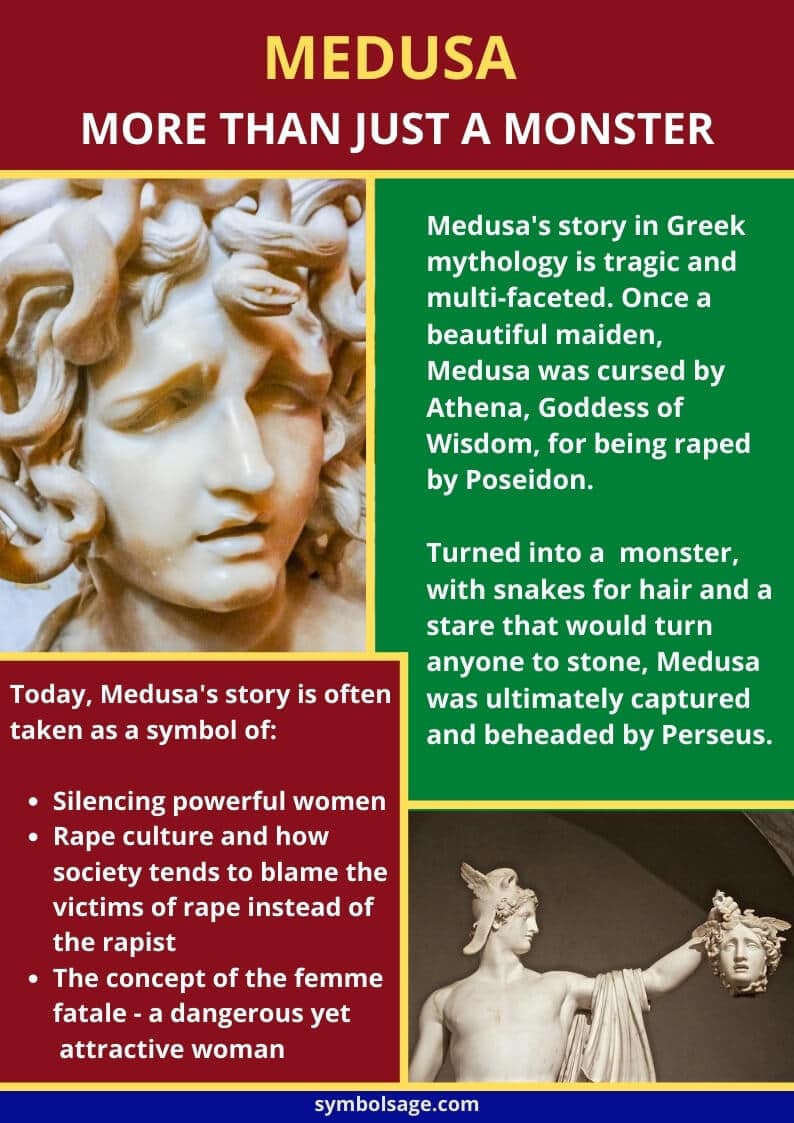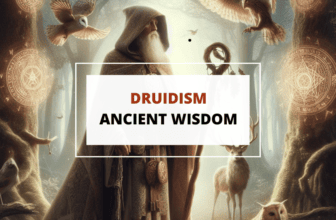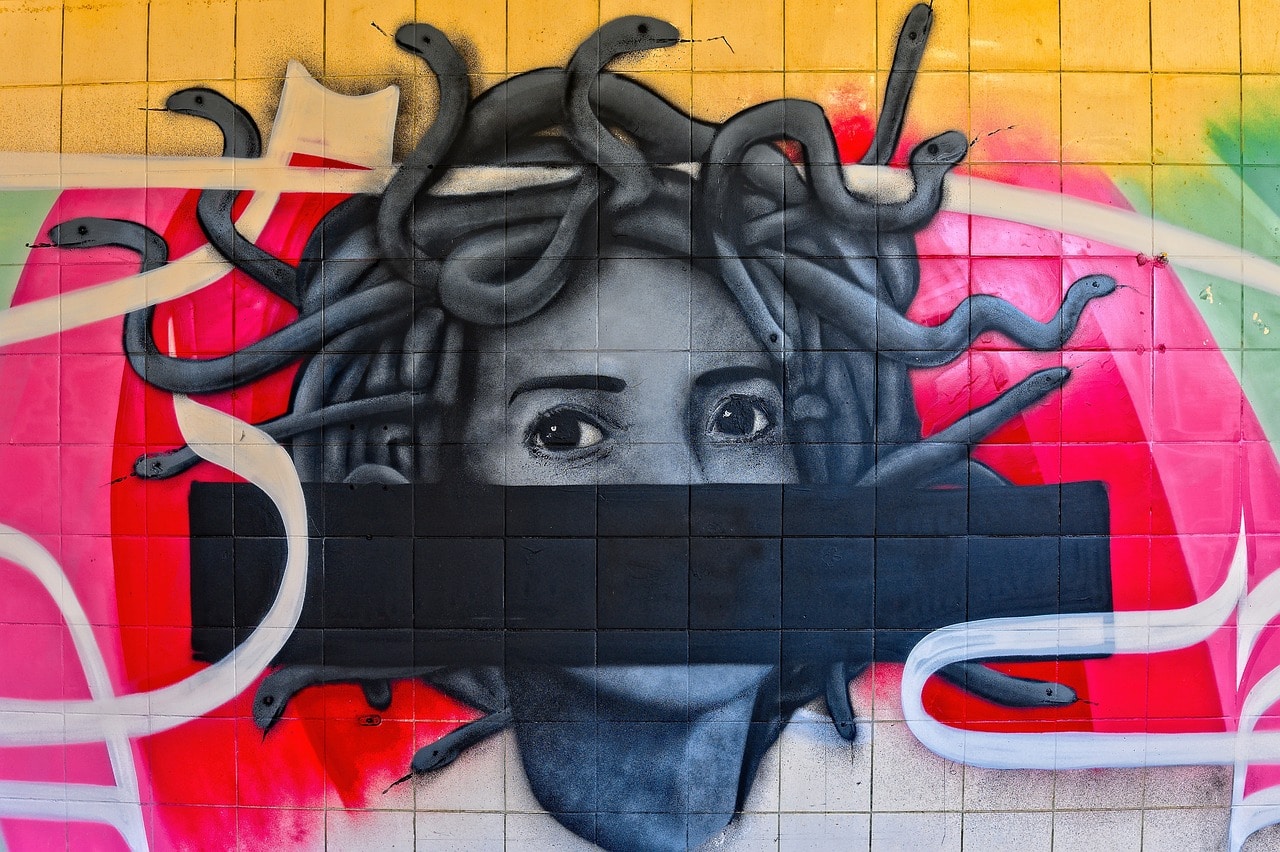
Table of Contents
One of the most recognizable figures in Greek mythology, Medusa is also the most famous amongst the Gorgons, three hideous female monsters with snakes for hair, and the ability to turn someone to stone just by looking at them.
While many have heard of Medusa as a horrible monster, not many know of her interesting, even poignant, backstory. Medusa is more than just a monster. She’s a multi-faceted character, who was wronged. Here’s a closer look at the story of Medusa and what she symbolizes today.
Who Was Medusa?
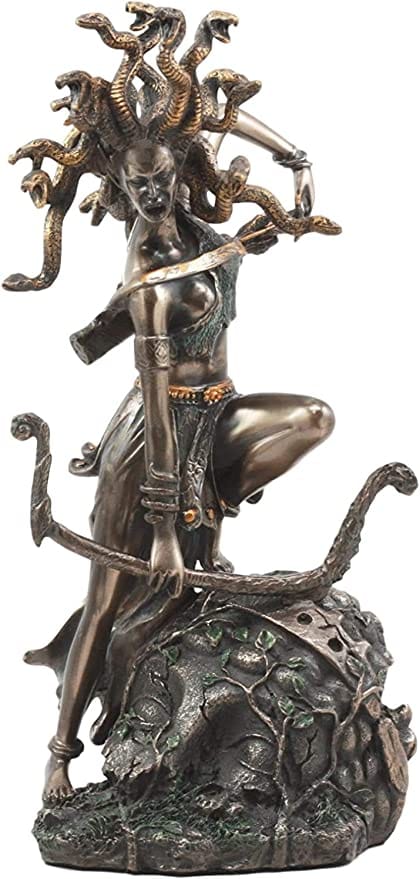
The name Gorgon comes from the word gorgos, which in Greek means horrible. Medusa’s lineage isn’t really clear. In some versions, her mother is said to be Gaia and her father is Phorcys. However, other sources cite Ceto and Phorcys as the parents of the Gorgons. Beyond their birth, there is little mention of the three Gorgons as a group and little is known about them.
Medusa was the only one amongst the Gorgon sisters who was mortal, although how she could be the only mortal daughter born to immortal beings isn’t clearly explained. However, she does have some immortal qualities, because although she ‘dies’ in the myths, her head continues to live on, in a manner of speaking.
In some myths, Medusa and her sisters were born as monsters, but in a popular version of her story, Medusa was a beautiful maiden who served in Athena’s temple.
The Rape of Medusa
Medusa’s beauty was so remarkable that even the powerful sea god Poseidon found her irresistible and tried to seduce her. However, when she did not reciprocate his affections, he attacked her and raped her right inside a temple dedicated to the goddess of Athena. The goddess was awakened with anger by what had happened inside her hallowed halls.
For some unknown reason, Athena did not punish Poseidon for the rape he committed. It could be because Poseidon was her uncle and the powerful god of the sea. This meant that technically, only Zeus could punish Poseidon for his crime.
It could also have been that Athena was envious of Medusa’s beauty and the attraction that men had towards her. And so, she used this as an opportunity to destroy Medusa’s beauty. Whatever the exact reason, Athena turned her wrath towards Medusa and punished her. She did this by turning her into a hideous monster, with snakes growing out of her head, and a deadly stare that would immediately turn anyone to stone if they looked into her eyes.
Some stories say that as a result of the rape, Medusa gave birth to Pegasus, the winged horse, as well as Chrysaor, the hero of the golden sword. However, other accounts say that her two children sprang from her head after she was slain by Perseus.
Perseus and Medusa
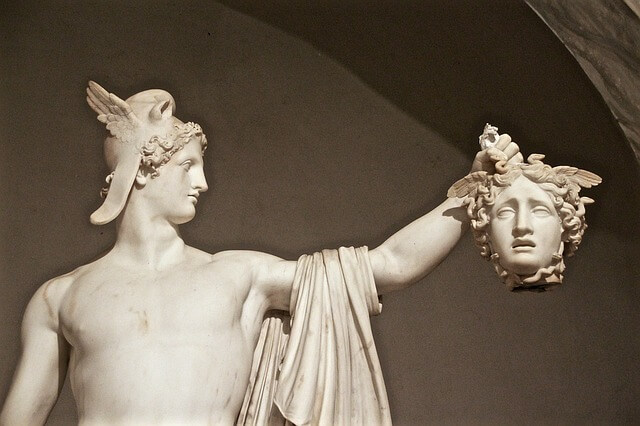
A demigod, the son of Zeus and Danae, Perseus is one of the greatest heroes of Greek mythology. He was sent on a quest to kill Medusa. With help from the gods and his intelligence, courage, and strength, he successfully located and beheaded her. Perseus used his shield as a mirror and avoided direct eye contact while battling her.
Even after her beheading, Medusa’s head was still powerful. Perseus used her severed head as a powerful weapon to slay the sea monster, Cetus. He was eventually able to save Andromeda, the Ethiopian princess who was about to be sacrificed to Cetus. She would become his wife and bore him children.
Medusa’s Head as a Protection Symbol
After his adventures, Perseus gave Medusa’s head to Athena. She placed it on her shield, the Aegis, as a protective emblem. This image of Medusa’s head is also referred to as the Gorgoneion. There’s something ironic, and almost wrong, in the fact that Medusa’s head ended up protecting the very deity who caused her unjust victimization.
However, the power that Medusa gains after her transformation – to turn people into stone with her gaze – can be seen as a symbolic protection against further violation or harm. This was given to Medusa by Athena, perhaps to protect her. If this is so, then did Athena do her a favor by turning her from a beautiful maiden into a hideous monster? Athena’s use of the Gorgoneion could be an acknowledgment of that power. However, this theory doesn’t really hold muster because if so, why did Athena aid Perseus in finding and killing Medusa?
Symbols of Medusa
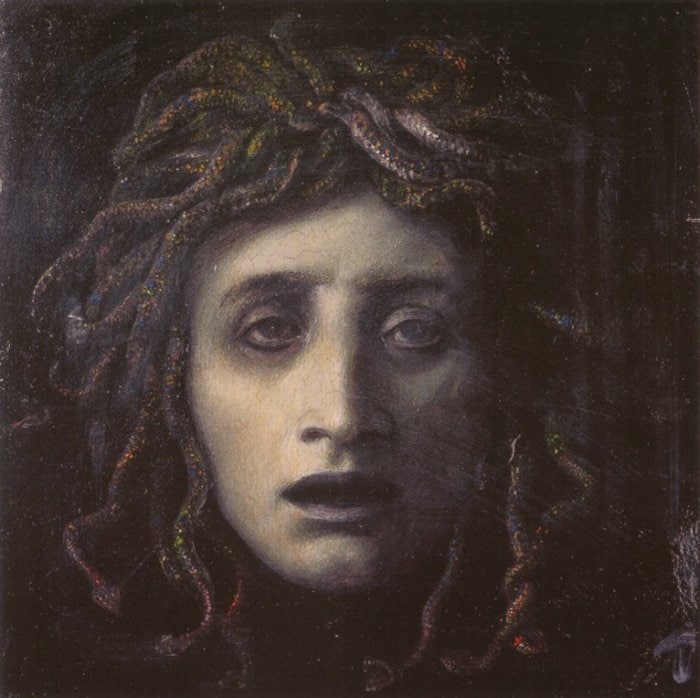
Medusa is one of the most iconic figures from Greek mythology, and as such, her image and what she represents have been used and adapted throughout history in various forms of art, literature, and culture. Here are some of the primary symbols associated with Medusa:
- Medusa’s Head: After being beheaded by Perseus, her head, which retained its petrifying gaze, became a potent symbol of power and protection. It could turn anyone who looked directly at it into stone.
- Snakes for Hair: One of the most distinguishing features of Medusa is her hair made of writhing snakes. Snakes can symbolize various things, including danger, fertility, rebirth, and transformation, depending on the cultural or historical context.
- Petrifying Gaze: Medusa’s ability to turn those who looked at her into stone symbolizes overwhelming power and a dangerous allure. It can also represent paralysis or stagnation, as those who gazed upon her were rendered immobile forever.
- The Gorgoneion: This is the term for Medusa’s head as a protective symbol. Athena placed it on her aegis, a shield or breastplate, as a protective emblem. The Gorgoneion was also used on ancient Greek coins, armor, and architecture as a symbol of protection against evil.
Over time, the symbols and meanings associated with Medusa have evolved, and she continues to be a subject of fascination, adaptation, and reinterpretation in various forms of art and culture.
Symbolism of Medusa’s Story
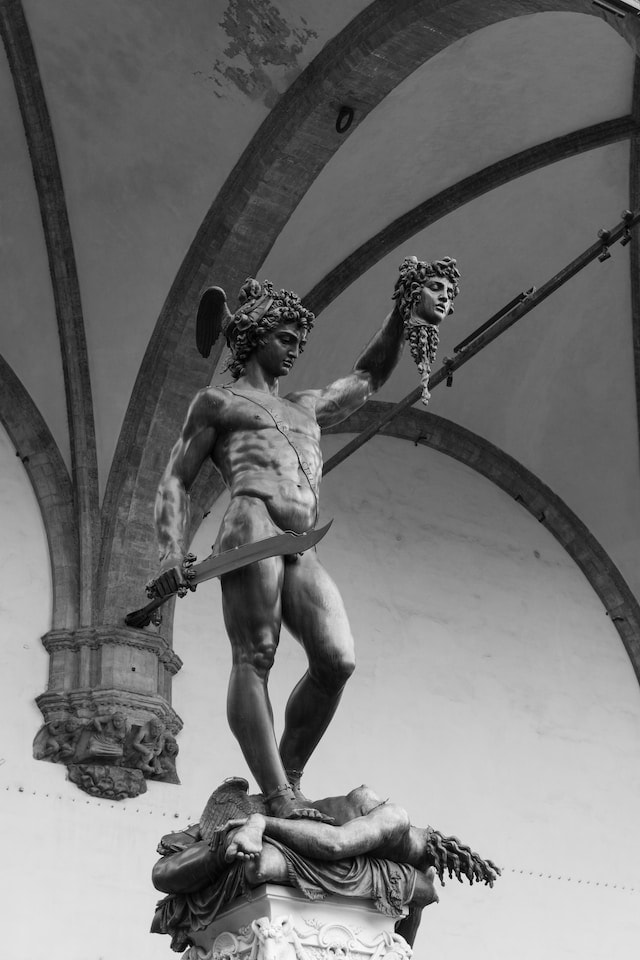
The story of Medusa, as it is traditionally told in ancient Greek myths, has been a subject of much discussion, reinterpretation, and critique, especially in modern times. Modern feminist interpretations of the myth often view Medusa as a symbol of female rage, power, and the consequences of patriarchal injustice. In these readings, the traditional narrative is challenged, and Medusa’s story is reclaimed as one of empowerment.
1. Silencing Powerful Women
The beheading of Medusa can be seen as symbolic of silencing powerful women who voice their sentiments. As this article from the Atlantic puts it: “In Western culture, strong women have historically been imagined as threats requiring male conquest and control. Medusa is the perfect symbol of this”.
2. Rape Culture
Medusa has been stigmatized and has unjustifiably been blamed for the consequences of male lust. She was unfairly blamed for “provoking” a god with her beauty. Instead of punishing her abuser, Athena, supposedly the goddess of wisdom, punished her by turning her into a hideous monster. It can be said that Medusa is an ancient representation of sexual stigma that still happens today. It’s still a matter of contention that rape victims are often blamed for the rape and, in some cultures, are vilified, ostracized and labelled ‘damaged goods’ by society.
3. Femme Fatale
Medusa is the archetypal femme fatale. Medusa symbolizes death, violence, and erotic desire. Once an enthralling beauty she was turned into a monstrosity after she was raped by a god. Such is her beauty that even powerful men couldn’t resist her charms. She can be equally enchanting and dangerous, and in some cases, she can be fatal. She remains one of the most identifiable femme fatales even today.
4. Female Rage and Power
Modern interpretations, especially feminist readings, often view Medusa as a symbol of female power, rage, and the consequences of patriarchal oppression. Her transformation can be seen not just as a curse, but as a form of empowerment, making her invulnerable to future harm.
From Horrible Monster to Beauty
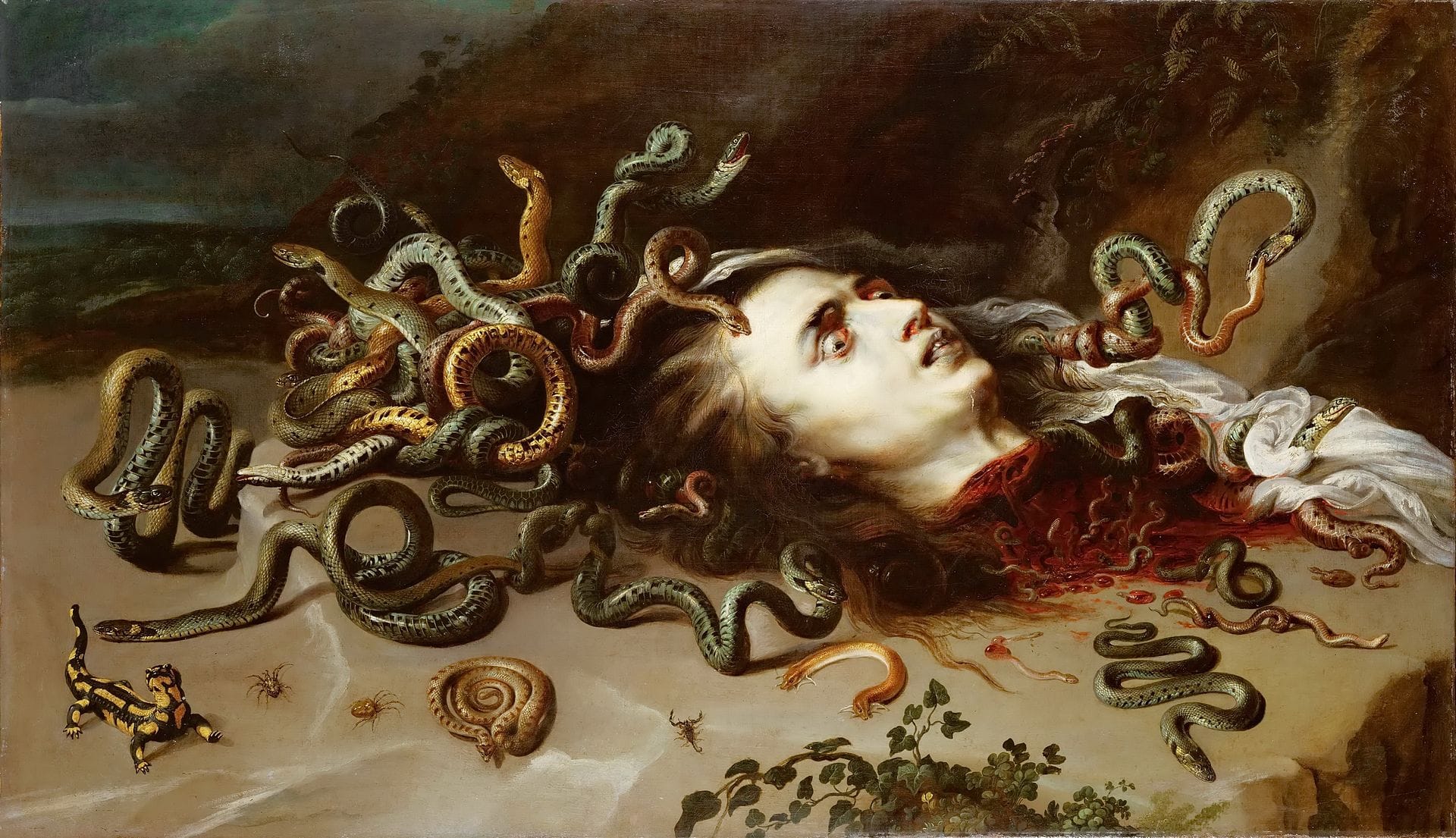
Unlike her myths, where she turned from a beauty into a monster, the depictions of Medusa have had the opposite trajectory.
Medusa was originally depicted during the Archaic period as a horrible monster. Painted on pottery and sometimes carved into funerary monuments, she was a terrible looking creature with bulging eyes, full beard, and a lolling tongue.
However, during the Classical period, the representations of Medusa began to change, and her features were increasingly feminized. She had smoother skin and her lips became shapelier. Classical artists gave her a makeover and a few centuries later, Roman and Hellenistic writers also interpreted her story differently in an attempt to explain her origins.
Artists took note of these changes and featured it in their works, making the images of Medusa more human. However, her fate is sealed and regardless of how many makeovers she has gone through, she still dies at the hand of Perseus.
Medusa in Modern Times

Being one of the most recognizable faces of Greek mythology, Medusa has been extensively represented in modern and ancient art. Her face is also ubiquitous in the covers of mythology books, especially Bulfinch’s and Edith Hamilton’s. She and her sisters have also been mentioned in one of the most famous works of literature of our time, A Tale of Two Cities by Charles Dickens.

Today, the image of Medusa has been taken on by powerful women, who have proudly worn a head full of snakes to depict power, sexuality, and the acknowledgment of their emerging role in society and politics. Some of the most famous female names have been associated with the image of Medusa, including Rihanna, Oprah Winfrey and Condoleezza Rice.
Medusa is also portrayed on the famous Versace logo, surrounded by the meander pattern. Other instances where Medusa is featured include the Flag of Sicily and on the coat of arms of Dohalice, Czech Republic.
In Brief
Beautiful, dangerous, powerful and yet a tragic figure – these are just some of the words used to describe Medusa. Such is her appeal that she terrifies and awes at the same time. Yet while many see Medusa as a monster, her back story shows her as a victim of lust and injustice. Her undeniable appeal will live on as her story is told from one generation to another.
